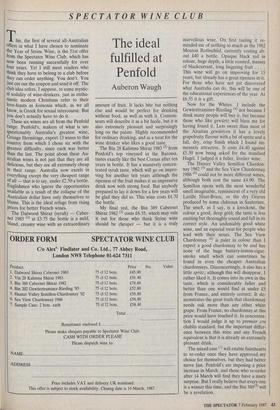SPECTATOR WINE CLUB
The ideal fulfilled at Penfold
Auberon Waugh
This, the first of several all-Australian offers in what I have chosen to nominate the Year of Strine Wine, is the 51st offer from the Spectator Wine Club, which has now been running successfully for over four years. Yet I still meet readers who think they have to belong to a club before they can order anything. You don't. You Just cut out the coupon and send it off. The club idea refers, I suppose, to some mystic- al sodality of wine-drinkers, just as enthu- siastic modern Christians refer to their love-feasts as koinonia which, as we all know, is Greek for sexual intercourse. But You don't actually have to do it.
These six wines are all from the Penfold range. Penfold's, makers of what is un- questionably Australia's greatest wine, Grange Hermitage, export 13 wines to this country from which I chose six with the greatest difficulty, since each was better than the last. The point about these Au- stralian wines is not just that they are all delicious, but they are all extremely cheap 111 their range. Australia now excels in everything except the very cheapest range of all — that is to say, under £2.50 a bottle. Englishmen who ignore the opportunities available as a result of the collapse of the Australian dollar have only themselves to blame. This is the ideal refuge from rising Prices for better French wines.
The Dalwood Shiraz (syrah) — Caber- net 1983 (1) at £3.75 the bottle is a mild, bland, creamy wine with an extraordinary amount of fruit. It lacks bite but nothing else and would be perfect for drinking without food, as well as with it. Connois- seurs will describe it as a bit facile, but it is also extremely pleasant and surprisingly long on the palate. Highly recommended for ordinary drinking, and as a treat for the wine drinker who likes a good taste. The Bin 28 Kalimna Shiraz 1983 (2) from Penfold's top vineyard in the Barossa, tastes exactly like the best Comas after ten years in bottle. It has a massively concen- trated syrah taste, which will go on impro- ving for another ten years although the ripeness of the fruit makes it an impressive drink now with strong food. But anybody prepared to lay it down for a few years will be glad they did so. This wine costs £4.70 the bottle.
My final red, the Bin 389 Cabernet Shiraz 1982 (3) costs £6.55, which may rule it out for those who think Strine wine should be cheaper — but it is a truly marvellous wine. On first tasting it re- minded me of nothing so much as the 1982 Mouton Rothschild, currently costing ab- out £40 a bottle. Opaque black red in colour, huge depth, a little roasted, masses of blackcurrant, long lingering fruit . . . . This wine will go on improving for 15 years, but already has a great ripeness in it. For those who have not yet discovered what Australia can do, this will be one of the educational experiences of the year. At £6.55 it is a gift.
Now for the Whites. I include the Gewilrztraminer-Riesling (4) not because I think many people will buy it, but because those who like gewiirtz will bless me for having found it. Less sweet than most of the Alsatian gewiirtzen it has a lovely grapefruity flavour with a bit of spritz and a full, dry, crisp finish which I found im- mensely attractive. It costs £4.40 against £5.50 now being asked for the standard Hugel. I judged it a fuller, livelier wine.
The Hunter Valley Semillon Chardon- nay 1982 (5) and the Sea View Chardonnay 1986 (6) could not be more different wines, although both cost the same £4.90. The Semillon opens with the most wonderful smell imaginable, reminiscent of a very old Laville Haut-Brion, or the dry Graves produced by some chateaux in Sauternes. The smell, as I say, is a knockout, the colour a good, deep gold; the taste is less exciting but thoroughly sound and full in its correct style. An undeniably good white wine, and an especial treat for people who lead with their noses. The Sea View Chardonnay (6) is paler in colour than I expect a good chardonnay to be and has none of the huge buttery-lemon-cigar- smoke smell which can sometimes be found in even the cheaper Australian chardonnays. Disconcertingly, it also has a little spritz; although this will disappear, I rather liked it. It comes into its own in the taste, which is considerably fuller and better than one would find at under £5 from France, and entirely correct. It de- monstrates the great truth that chardonnay needs oak more than any other white grape. From France, no chardonnay at this price would have touched it. In concentra- tion I would judge it up to premier cru chablis standard, but the important differ- ence between this wine and any French equivalent is that it is already an extremely pleasant drink.
The mixed case (7) will enable fainthearts to re-order once they have approved my choice for themselves, but they had better move fast. Penfold's are imposing a price increase in March, and those who re-order after 14 March will find they have a nasty surprise. But I really believe that every one is a winner this time, and the Bin 3890 will be a revelation.


















































 Previous page
Previous page